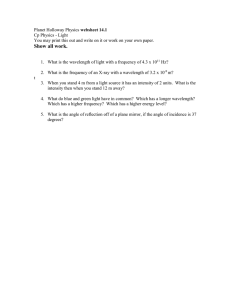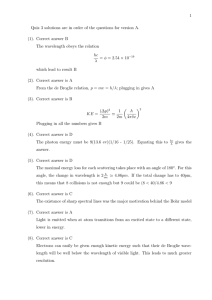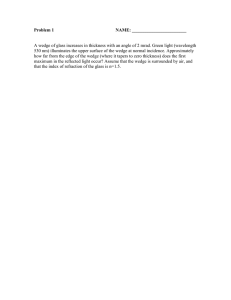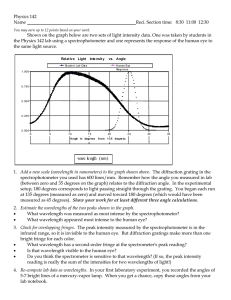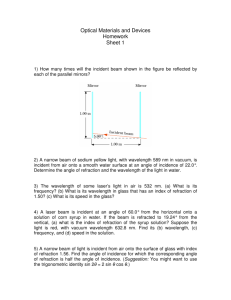Characterizing sub-nanometer narrow bandpass filters
advertisement
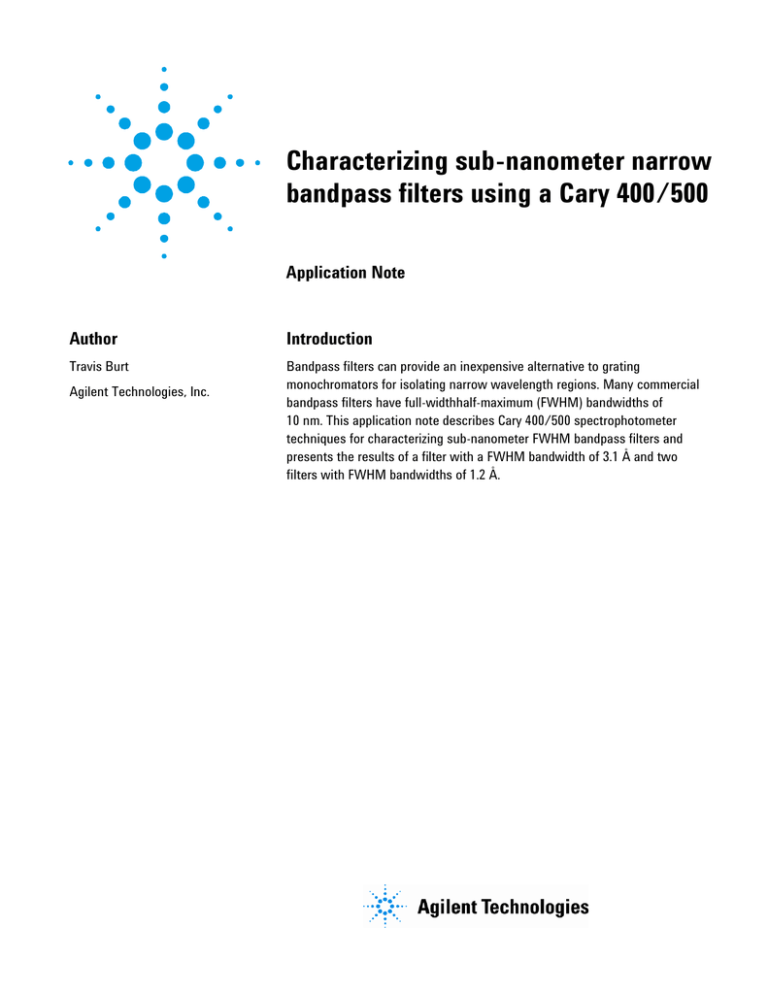
Characterizing sub-nanometer narrow bandpass filters using a Cary 400/500 Application Note Author Introduction Travis Burt Bandpass filters can provide an inexpensive alternative to grating monochromators for isolating narrow wavelength regions. Many commercial bandpass filters have full-widthhalf-maximum (FWHM) bandwidths of 10 nm. This application note describes Cary 400/500 spectrophotometer techniques for characterizing sub-nanometer FWHM bandpass filters and presents the results of a filter with a FWHM bandwidth of 3.1 Å and two filters with FWHM bandwidths of 1.2 Å. Agilent Technologies, Inc. Discussion Instrument parameters and sample mounting require careful attention to ensure successful characterization of sub-nanometer FWHM bandpass filters. These can be challenging samples to the spectroscopist but when approached correctly the method clearly confirms the abilities of Cary 400/500 spectrophotometers. It is recommended practice that the spectrophotometer be warmed up for a 1 hr period and then re-initialized (reset) by turning it off and then on again immediately. A wavelength validation test should also be performed using the validation software application and checked before any measurements are attempted. Figure 2. Filter angular dependance It is clear from Figures 1 and 2 that attention should be paid to the large temperature variations that are present in some laboratories but a 1° angle of incidence is not likely to be exceed unless the sample holder is installed incorrectly or some foreign material becomes lodged between the filter and the solid sample slide. The function of bandpass filters are based on interferometric principles and so they are sensitive to the angle of the incident light. The peak wavelength shifts (decreases) to shorter wavelengths with increasing angle. Conversely, peak wavelength increases slightly with temperature. To account for temperature variations narrow bandpass filters are measured at specified temperatures - generally 23 °C. Equation [1] may be used to determine wavelength shifts of a filter in collimated light with incident angle of up to 15 degrees. I = Io[1 - (Ne/N*)2 sin2 ]1/2 [1] Where; I = wavelength at angle of incidence Io = wavelength at normal incidence Ne = refractive index of external medium N* = effective refractive index of filter (refer to manufactures specifications) = angle of incidence. For convergent or divergent light the wavelength shift is slightly less where the dependent variable is the cone angle. A good approximation for determining wavelength shift with cone angle is to define as the cone angle and divide the result of equation [1] by two. Figure 1. 1.0 Filter temperature dependance 2 The Figures 1 and 2 show the general trends of peak wavelength shifts with temperature and angle. Broadly speaking a temperature change of 5 °C or 1° in the angle of incidence will move the peak wavelength by up to 0.05 nm. First the front sample beam aperture is inserted and the instrument is set to idle at the filters center wavelength at a practical SBW (eg. 1.5 nm) The aperture is moved up and down until the maximum signal is achieved in the %T display and then locked into place using the locking nut. A 5 mm aperture is then inserted into the front and rear stands of the rear beam and the signal is minimized. The 5 mm apertures are used in the rear beam because they are easier to align than the 1 mm apertures but the full dynamic range of the spectrophotometer needs to be preserved by placing an attenuator in the rear beam. We found a 1.1 Abs rear beam attenuator (RBA) was sufficient to bring the baseline scan below 100% during its collect. Finally, after the two 5 mm apertures and RBA are positioned in the rear beam the second 1 mm aperture is inserted into the back of the sample beam. Once again the aperture height is optimized to achieve maximum signal throughput and then locked into place. Instrument considerations The spectrophotometer should be configured to reduced slit height, double beam mode. The independent control tab should be activated to enable spectral bandwidth (SBW) values below 0.040 nm to be entered. The SBW and data interval should be set to ensure an adequate number of data points are collected across the bandwidth of the filter. The strong dependence of FWHM and peak wavelengths on the SBW can be seen in Figure 3. The decrease in the peak wavelength and the maximum percent transmission can be seen as SBW is increased. The front and rear aperture alignment may need to be revisited to ensure optimum throughput has been achieved. Both 100%T and 0%T background scans need to be performed before the sample is measured. Averaging time should be chosen such that an acceptable signal to noise ratio is achieved. For subnanometer FWHM bandpass filters this value is likely to be at least above 5 seconds. This amounts to approximately 20 min per scan for a visible spectral region of 3 nm. Alternatively the signal to noise (S/N) control feature of the software can be used to minimize scan times. By selecting a desired S/N value scan rates will automatically increase in less noisy regions of the spectrum. Spectra of three different narrow bandpass filters can be seen in Figures 4 and 5. Figure 3. Filter SBW dependance In the Cary 400/500 the reduced slit height cone angle can be reduced from a maximum of 5.0 degrees to 0.6 degrees using 1 mm apertures at positions of 50 mm prior to, and 50 mm after, the sample. A cone angle of 0.6 degrees will minimize the shift in the peak wavelength of a narrow bandpass filter to less than 0.05 nm. Care must be taken to ensure that the 1 mm apertures are located at the center of the beam profile and that they are parallel to the beam axis. This is achieved by maximizing flux throughput before the sample is inserted into the instrument. 3 Conclusion Figure 4. Spectrum of narrow bandpass filter Successful measurement of sub-nanometer bandpass filters can be performed on a Cary 400/500 spectrophotometer. Two 1 mm apertures are used 50 mm either side of the sample in the front beam and two 5 mm apertures with 1.1 Abs rear beam attenuation are used in the rear beam. Correct alignment of the apertures is critical to achieving optimum throughput of the spectrophotometer prior to measurement. The FWHM, peak wavelength and peak transmission for three narrow bandpass filters were measured and found to be, respectively: 0.31 nm ,709.277 nm, 26.17 %T, 0.12 nm, 531.452 nm, 65.53 %T, 0.12 nm, 532.578 nm, 42.22 %T. Figure 5. Spectrum of narrow bandpass filters www.agilent.com/chem © Agilent Technologies, Inc., 2000, 2011 Published March, 2011 Publication Number SI-A-1193
